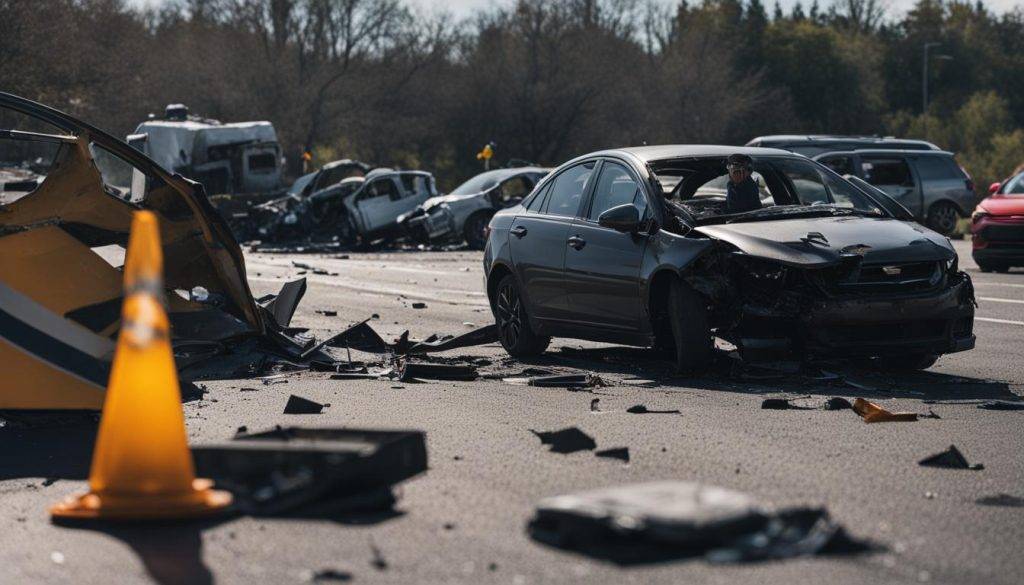
Stay Safe on the Road: Essential Road Safety Tips

The Backbone of Your Vehicle: Exploring the Vehicle Frame
If you’ve been in an auto accident, it’s important to know what steps to take to ensure your safety and protect your rights. Follow this step-by-step guide to navigate the aftermath of an auto accident and ensure you handle the situation correctly. From securing the safety of all involved to reporting the accident to the necessary authorities, this guide covers all the essential actions you need to take.
Key Takeaways:
- Ensure the safety of yourself and others involved in the accident.
- Seek medical assistance if there are any injuries.
- Gather and exchange information with the other driver.
- Contact your insurance provider to start the claims process.
- Understand the potential impact on your insurance rates.
Ensure Safety and Seek Medical Assistance
The first priority after an auto accident is to ensure the safety of yourself, your passengers, and any other individuals involved. This includes securing kids, pets, seniors, and disabled individuals to ensure their well-being.
Start by checking for injuries. If anyone is hurt, it is crucial to seek immediate medical assistance. Even if injuries are not apparent, it’s still important to get a medical evaluation, as some injuries may not be immediately obvious.
Move to a safe area if possible. If the accident occurred in a hazardous location, such as a busy intersection or a highway, it’s essential to move to the side of the road to avoid further danger. However, if moving the vehicles poses a risk or obstructs traffic, it’s best to leave them in place and wait for the authorities.
If the accident is severe or there are serious injuries, call 911 to request medical help and report the accident to the police. Promptly contacting emergency services is crucial to getting the necessary medical attention and documenting the incident for insurance purposes.
Conclusion:
Ensuring safety and seeking medical assistance is the first and most important step after an auto accident. Secure and protect all individuals involved, check for injuries, and move to a safe area if possible. If the accident is severe or there are serious injuries, contact 911 for immediate medical help and to report the incident. Taking these actions promptly will help ensure the well-being of everyone involved and provide the necessary documentation for insurance purposes.
Gather Information and Document the Accident
After ensuring the safety of all individuals involved, it’s important to gather and exchange information with the other driver. This includes names, insurance information, and contact details. It’s crucial to exchange this information to facilitate the claims process and ensure that all parties involved can be reached if necessary.

In any accident situation, it’s essential to avoid engaging in discussions about responsibility at the scene. These discussions can be emotionally charged and may complicate matters during the claims process. Instead, focus on gathering factual information and documenting the details of the accident.
Avoid Roadside Discussions About Responsibility
Once you have exchanged information, it’s important to request a copy of the police report and make note of the officer’s badge number. The police report is an official document that provides an objective account of the accident. It can serve as valuable evidence when filing an insurance claim or pursuing legal action, if necessary.
Thoroughly documenting the accident is essential for insurance claims and potential legal proceedings. Take photographs of the damages to your vehicle and any other vehicles involved. Additionally, create a diagram illustrating the sequence of events leading up to the accident. These visual aids can provide a clear and objective representation of the incident.

By gathering and documenting this information, you can ensure that you have the necessary evidence to support your insurance claim and protect your rights in the event of any legal proceedings. Remember, comprehensive documentation is key to a successful claims process and ensuring that you receive the appropriate assistance and compensation.
Start the Claims Process and Consider Insurance Impact
Once the immediate steps have been taken, it’s time to start the claims process with your insurance company. Contact your insurance provider to notify them of the accident and provide them with the necessary documentation.
Whether or not your insurance rates will increase after an accident depends on various factors such as fault, the severity of the accident, and your individual policy. Consult your insurance provider for specific details about your coverage and potential rate changes.
Understanding how insurance pays out after an accident will help you navigate the claims process and ensure you receive the appropriate assistance and compensation.
FAQ
What should I do immediately after an auto accident?
The first priority is to ensure the safety of all involved. Check for injuries and seek medical assistance if necessary. Secure kids, pets, seniors, and disabled individuals. If the accident is severe or there are serious injuries, call 911 to request medical help and report the accident to the police.
What information should I exchange with the other driver?
It’s important to exchange names, insurance information, and contact details with the other driver. Avoid discussions about responsibility at the scene. Request a copy of the police report and make note of the officer’s badge number for future reference. Thoroughly document the accident by taking photos of the damages and creating a diagram illustrating the sequence of events.
How do I start the claims process with my insurance company?
Contact your insurance provider to notify them of the accident and provide them with the necessary documentation. Whether or not your insurance rates will increase after an accident depends on various factors such as fault, the severity of the accident, and your individual policy. Consult your insurance provider for specific details about your coverage and potential rate changes.



